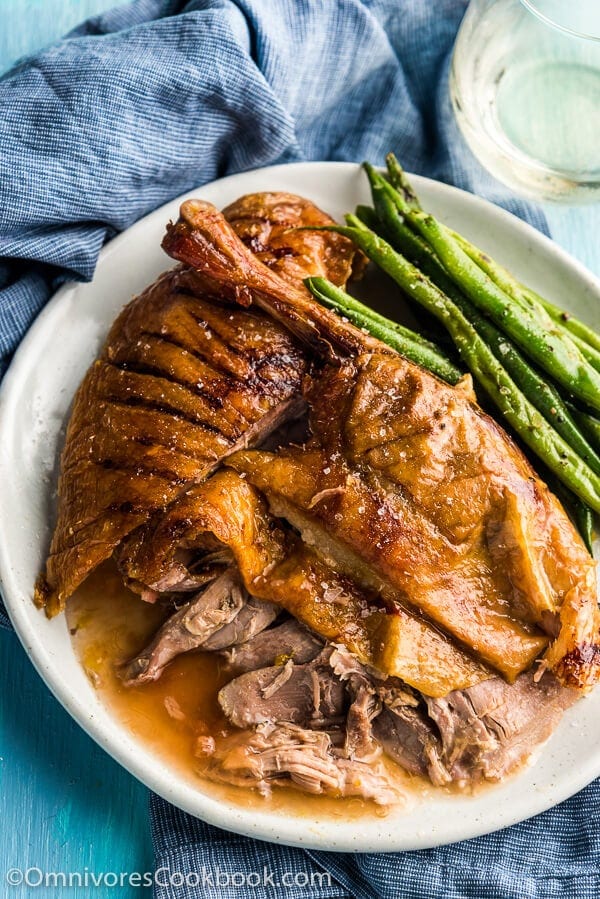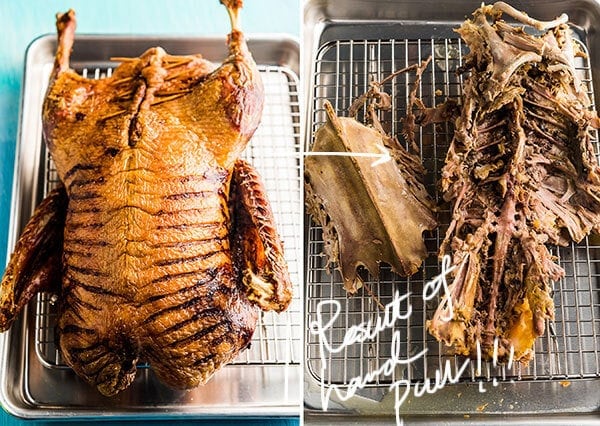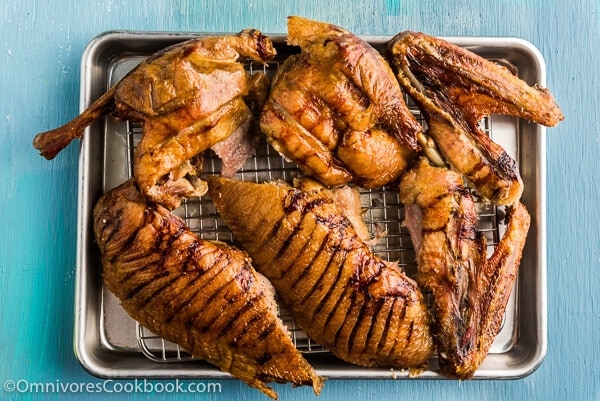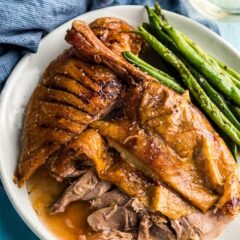
Having grown up in Beijing, I have a special attachment to duck. We’re spoiled by ubiquitous perfectly roasted Peking duck, a luxurious yet affordable dining choice that we enjoy a few times a year. I can finish half a duck myself. I enjoy eating the duck skin by itself with a bit of sauce (without the meat and without the pancake). In my world, it tastes way better than crispy bacon.
Since moving to the US, I’ve been craving duck.
The first time I dealt with a whole duck, I slow cooked it Mediterranean style. I quartered the duck, placed it on a bed of vegetables and herbs, and slow cooked it until tender. Right before serving, I crisped up the skin by heating the duck pieces under the broiler. It generated nearly duck-confit texture.
It was almost perfect, but my friend and reader Saint Phlip told me there was a better way.
The best slow roast duck
This recipe was originally shared by the chef of a hotel restaurant in Marietta, Ohio. According to Saint Phlip, it’s the tastiest duck she’s ever tried.
To cook the duck, you stuff it with several citrus fruits, then roast it at a very low temperature (95 to 120 C / 200 to 250 F). It requires a long, slow roast. But you don’t need to do anything during the roasting. No flipping, no touching.


When you’ve almost forgotten the duck, 5 hours later, you will suddenly smell a wonderful aroma coming from the kitchen. That’s when you know the duck is getting good.
The next 2 hours will be the most difficult. Your room will be filled with the wonderful roasting fragrance that reminds you of a steak house. You’ll start to check on the duck every 10 minutes, wondering why it’s still not ready. DO NOT pull out the duck now. Be patient!
When you start to worry that you’ve roasted it for too long and suspect the duck meat has lost its moisture, your dinner is ready.
You will be amazed when try to move the duck onto a carving board. You might accidentally crack the skin apart or pull a leg off. I know it’s cliche to say this, but the duck is literally fall-off-the-bone tender (as proof of my words, see the picture below). You might end up serving a “pulled duck”, since it’s nearly impossible to keep the whole thing intact. Restrain yourself from snacking on the crispy skin. You might finish the whole thing before you have a chance to serve your guests.

Cooking notes
Don’t be scared away by the long cooking time of this recipe, because:
- The active prep time is 10 minutes. And you’ll need another 10 minutes to cook the sauce and serve the duck. In total, there’s only 20 minutes of active cooking time.
- You can cook the duck one day or several days ahead, freeze the duck, and serve it later.
- If you’re serving the duck for a party, you can start roasting it in the morning, then heat it up before dinner.
Compared to roasting a perfect chicken, roasting the best duck is much easier. And it is definitely more festive.
There are a few good ways to serve the duck. In the recipe below, I introduce the original sauce recipe – a delightful and sweet sauce made from white wine and fruit preserves.
For those who miss a perfectly roasted Peking duck from back home, cook duck pancakes, and serve everything with chopped green onions and cucumbers. I guarantee you the dish will taste just like home.
For those who enjoy a savory sauce, head over to the Mediterranean duck recipe and cook the olive sauce.

Do you like my recipes? Sign up our weekly newsletter to get the latest updates delivered to your inbox and a FREE e-cookbook that contains my top 30 most popular recipes!
Chinese Cooking Made Easy
Are you new to this website? This free email series is a great place to start. I’ll walk you through a few of my most popular recipes and show you how and why they work. You’ll quickly start to cook better Chinese food in your own kitchen.

Duck de Marietta (The Best Slow Roast Duck)
Ingredients
Duck
- 1 2.5 kg / 5 to 6 pound whole duck (I used D'Artagnan Rohan Duck)
- 5 to 6 mixed citrus fruits blood orange, lemon, and/or mandarin, peels removed
- Sea salt
Sauce (*see footnote)
- 4 tablespoons jam of your choice (blueberry, apricot, etc.)
- 1 cup white wine
- 2 to 4 tablespoons potato starch (or cornstarch)
Instructions
- Adjust oven rack to the lower third. Preheat oven to 120 C (250 degrees F). Line a baking pan with aluminium foil (for easy cleanup) and top with a V-rack.
- Prepare a plate. Transfer the giblets from the duck to the plate. Use a pair of poultry shears to remove the duck neck and trim the neck skin. Do not trim any skin from the bottom of the duck, because it will keep the meat moist during roasting. Save the duck neck for making sauce or stock. Save the giblets for cooking or making stock.
- Place duck on a working surface or a cutting board. Stuff citrus inside of the duck, using as many fruits as you can. Use a few toothpicks to seal the bottom of the duck, to secure the fruits inside.
- Use a sharp paring knife to score the duck breast, about 1 cm (⅓ inch) apart. This will help the duck render fat faster and create a crispy skin. If you’re not familiar with this process, I suggest you start slow. The thickness of duck skin is not consistent. You need to avoid slicing through the meat, which will cause the duck to lose moisture. Gently press the knife. You might need to slice a few times to get the cut just right. (*see footnote 1)
- Rub both sides of the duck with plenty of sea salt. Place duck on the V-rack, breast side up.
- Bake until the skin turns golden brown, 6 to 7 hours (depending on the thickness of the duck skin). You do not need to flip the duck or monitor the process.
- (Optional) When most of the duck fat has rendered and the skin has become thin (usually 6 hours to 6.5 hours), turn up the heat of the oven to 260 degrees C (500 F) to brown the duck for another 5 to 10 minutes. This method works better when you choose a duck breed with thinner skin (or a duck that was air-chill processed). The skin will crisp up nicely and the meat will remain more juicy.
- Remove the duck from the oven and let rest for 15 minutes. Do NOT cover the duck with foil. This step further crisps up the skin. The stuffing will keep the duck meat hot.
- Transfer the duck onto a large cutting board. Carefully remove the citrus fruits (they will be very hot!) from the duck with a fork or a pair of tongs, and discard them.
- To carve the duck beautifully, you can refer to this video. Alternatively, you can simply pull the meat apart by hand.
- Transfer the rendered duck fat into a small bowl. When it has cooled off, cover with plastic wrap and store it in the fridge. Save for later use.
Option 1 - Fruity sauce
- While resting the duck, cook the fruit sauce.
- Dissolve potato starch in a few tablespoons of the white wine.
- Heat the rest of the white wine in a small saucepan until warm. Add jam of your choice. Stir and mix so that the jam incorporates with the wine. When the liquid comes to a simmer, taste it and adjust the flavor by adding more wine or jam. Remove the pan from the stove.
- Stir the potato starch slurry again to let it fully dissolve in the wine. Slowly pour it into the sauce, stirring at the same time. Add enough slurry to get the sauce to the desired thickness.
- Pour a few spoonfuls of the sauce onto a serving plate. Place the carved the duck onto the sauce. Serve warm with extra sauce on the side.
Option 2 - Peking duck
- Cook duck pancakes (or use store-bought ones). Steam to heat them up while resting the duck.
- Serve duck and pancakes with hoisin sauce, sliced green onion, and sliced cucumber.
Storage
- If you’re not serving the duck right away, wrap the meat in aluminum foil and let it cool down to room temperature. Move it to a ziplock bag, press out as much air as possible, and store it in the fridge for up to 2 days or in the freezer for up to a month.
- To reheat, place the duck, skin side up, on a roasting pan. Transfer into the oven and preheat to 260 degrees C (500 F). Bake until the duck heats up and the skin turns crispy, 10 to 15 minutes.
(Optional) Giblets
- Cut duck giblets (liver, heart, and gizzard) into even-sized chunks and combine with a spoonful of Chinese distilled liquor (白酒, bai jiu), vodka, or Shaoxing wine in a small bowl. Add a teaspoon of cornstarch and season with salt. Mix well. Marinate for 5 minutes.
- Heat oil in a skillet. Gently cook the giblets over medium low heat until cooked through and the surface browned.
- Season with black pepper and serve warm.
Notes
- Many recipes suggest puncturing the duck meat with a sharp knife or fork. I personally do not like that method so much. It is slower and the duck won’t look so pretty compared to one with scored skin.

Did you make this recipe?
I’d love to hear how it turned out for you! Please take a moment to leave a 5-star rating ⭐️ and share your thoughts in the comments further down the page. It really helps others discover the recipe too.
This is a festive dish, so we’re not going to count calories here 🙂

Kathryn
Looking forward to making this for Thanksgiving 2021! I salt the duck and air them in the fridge for 24 hours prior, but can I also put the citrus fruit in the duck as well? Or should I wait until time to roast?
Maggie Zhu
I think you totally can and I think either way will work.
Rich in CA
Hi, Can I do this on a bbq grill? Same temp…?
Thanks
Maggie Zhu
I think you definitely can!
Mary Tipton
This turned out to be the most delicious and the tenderest duck I’ve ever cooked. Loved it! And it was easy too.
Felipe Gonzalez
Absolutely amazing. I did 90°C for 8 hours, then 15 mins at 180°C. It came out perfect.
Natalia
This recipe is amazing. I was quite scared to cook a duck, to be honest, having never done it before, but this recipe is very forgiving. Entire family enjoyed it tonight. Thank you from all of us.
Karen Schoonover
My favorite recipe for duck
Fred Peipman
Super-easy with spectacular results! This is my go-to recipe for duck, and guests and family are so impressed. Thank you!
L
This recipe looks amazing, and so simple! While reading your post I was curious to see the Chicken à la Benson recipe too, but I can’t seem to find the page on your site for some reason? (https://omnivorescookbook.com/chicken-a-la-benson isn’t working for me)
Maggie
The recipe is not on the site anymore. Every year I clear up recipes that fewer people cook. Sorry about that!
Barbara Jean
I’ve made this twice… a Maple Farms duck at Thanksgiving, and a Kirkwood duck today. They were both delicious, and so easy! I had never cooked a duck before, so I’m very happy to have stumbled upon this recipe. Thank you so much!!
Xander Warrender
Cooked this for myself for Xmas dinner. I’m just an old guy, not much of a cook but this was a breeze to make.
And “fall of the bone” is a gross understatement — it’s like bone and meat hated each other and couldn’t wait to part company!
I did it in a small roasting pan and the only thing I’d change would be to pull off the lid for the last bit to crisp up the skin a little.
Xander
Oh and, in the same way I’ve done other duck recipes over the years, I covered the bottom of the pan with vegetables (in this case, it was thick slices of sweet potato); it guarantees the duck won’t stick to the bottom of the pan. They cooked in the juices of the duck and were great.
Maggie
So happy to hear you enjoyed the dish! The description is spot on! Maybe I should quote you in the blog post 🙂
Dana
I’m in the middle of cooking this and would have loved to have a target meat temp for my probe. Are we going for chicken temp eg out at 155 beast meat? I’m a avid cook – by temperature is so important for meat moisture.
Dana
Won’t be doing this again, at least with the maple leaf farms duck anyway. Probe got up to 180 in the breast. Way way too high to be edible. I made a fantastic sauce that made the breast meat sort of edible but I’m sticking with duck confit. 😉
Chris Woldemar
Hi Maggie, we are making for Christmas dinner. What do you think about cooking the duck spatchcock style?
Stephen Anger
Hi Maggie,
This looks so good, and I am making it for Christmas this year. I wanted to know how far in advance you can make the fruit sauce?
Maggie
You can make the sauce 1 to 2 days prior serving day. It might become a bit thicker after storing in the fridge but you can bring it back by heating it gently and stir in some water if needed.
Quinn
Hi Maggie
We love duck and usually go through a long, involved process of brining and drying before roasting. This was simple and delicious! Thank you so much.
As I have mentioned, my wife grew up in Beijing and occasionally she talks about a dish called Eight Treasure Duck. I’ve looked it up online, and from what I can tell there are main two variants: with the bone and boned. And the stuffing is a widely varied as you would find for an American Thanksgiving dinner. So my question is this: can you I use your duck recipe, but replace the stuffing with an “Eight Treasure” stuffing, and if so, can you recommend an Eight Treasure stuffing recipe to use? Any other changes you would make?
Thank you so much!
Cheers,
Quinn
Maggie
I do have a sticky rice and Chinese sausage stuffing that I think might be perfect for this purpose: https://omnivorescookbook.com/sticky-rice-stuffing/
The only thing I’m not sure is, if the stuffing will keep the meat as moist as the citrus does. I think the juice and acid from the citrus also serves as a tenderizer, which makes the meat extra tender after such a long roasting time. The other thing I’m not sure is, how to prepare the stuffing (you probably want to under cook it), so it’s not overly soggy and greasy after roasting.
I wish I have a better answer but I cannot promise a good result without testing the method. I’m gonna read up more on the eight treasure duck and maybe do some experiments.
Quinn
Thanks Maggie. I think you are making the right call on undercooking the rice. Right now my plan is to follow your Duck de Marietta recipe, but use the Eight Treasure stuffing described here, which also calls to undercook the rice:
https://www.yumofchina.com/eight-treasure-duck/
I have a few days before I give this a try, so let me know if you have an suggestions…and wish me luck!!!!
Cheers,
Quinn
Katerina
Dear Maggie, thank you for the recipe. I plan on doing it for Xmas. Do you think it will go well with the e original bitter orange sauce from the canard a lorange classic recipe? If so, any suggestions for side dishes?
Maggie
Yeah I think it will go well with a bitter orange sauce.
For side dishes, you could check out:
https://omnivorescookbook.com/glazed-carrots/
https://omnivorescookbook.com/oven-roasted-green-beans/
https://omnivorescookbook.com/five-spice-garlic-roasted-potatoes/
https://omnivorescookbook.com/milk-bread-rolls/
Or you can do a really simple green salad with vinaigrette dressing.
Stuart
Made this yesterday to celebrate a birthday. It turned out fantastic: crispy and full of flavor. It was stuffed with lemons, limes, and an orange. For jam I used plum sauce, pan drippings, and followed the recipe. Excellent over a bed of white rice.
Thanks again Chef Zhu!
Celina
We made this last night, it was amazing. No duck fat all over the place! It smelled amazing! It tasted amazing! There were NO leftovers (except the duck fat which is already being used for other things).
Thank you so much.
Katinka
Hi Maggie,
Should I bring the duck to room temperature before cooking?
Maggie
I don’t think you need it (although you can). The cooking temperature is so low that it will naturally bring back the temperature of a refrigerated duck.
Sue R
I loved getting a tender duck with very crispy skin and not needing to fiddle around flipping it etc. I did leave it 3 days on a rack in the fridge to dry the skin out more , dried with paper towel and sprinkled on Chinese 5 spice, garlic powder and salt. It was a 1.9kg duckling so cooked it at 120C for 5 hours then at 260C till really crispy. Didn’t need sauce. Perfect as is.
Bill
This was brilliant. Restaurant quality but super easy. I used two navel oranges and one lemon to cut the sweetness. At the end I drained off the fat but added the remaining drippings to the sauce. It added an extra boost to the sauce without the sweetness of just using the jam. After 7 hours at 110 degrees Centigrade with a 10 minute finish at 200 degrees it was still moist and tender with great crisp skin. Thanks for this recipe. Gives me a new appreciation for duck.